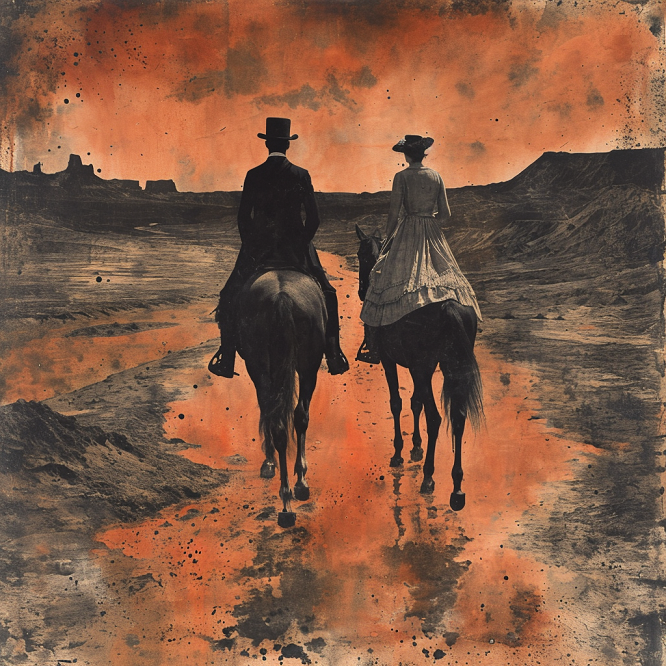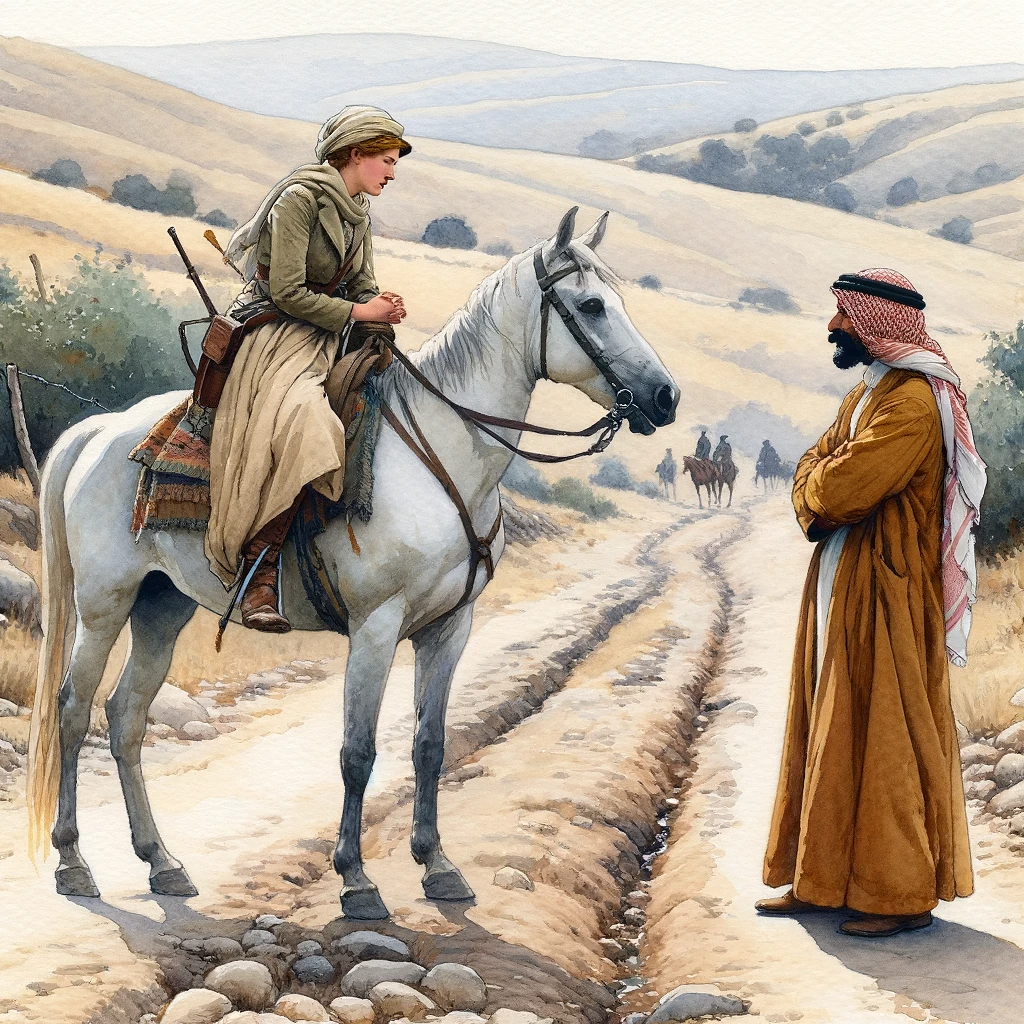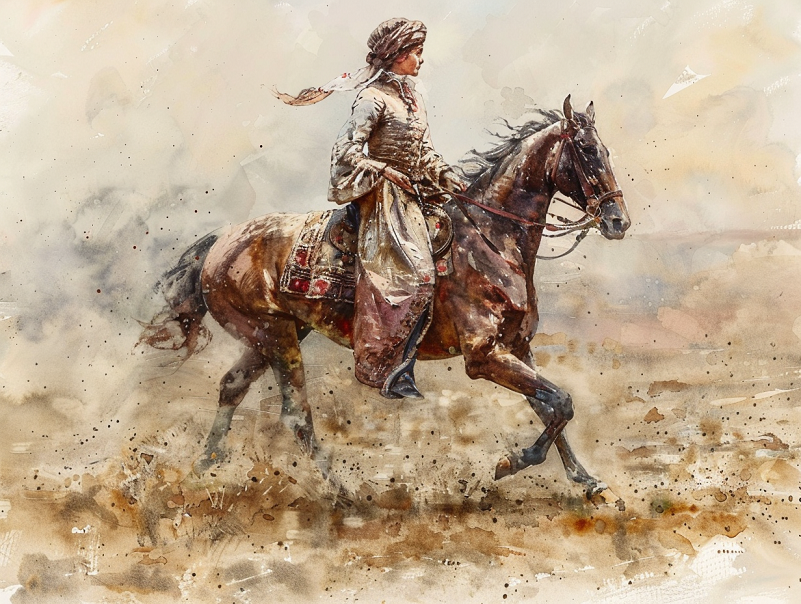“Pilgrimage to Nejd: The Cradle of the Arab Race” is one of two books authored by Lady Anne Blunt offering a captivating glimpse into the rich tapestry of Arabian culture and geography, as seen through the eyes of Lady Anne Blunt. With her remarkable heritage and keen intellect, Lady Anne embarked on a journey from Aleppo, Syria, into the very heart of Central Arabia. Her adventures in the late 19th century bring to life the shifting sands, timeless traditions, and the distinguished Arabian horse. This account delves into her experiences, exploring the landscapes of Syria, Jordan and Saudi Arabia, her interactions with local tribes like the Shammar and Anizzah, and highlights the lasting impact of Arabian equine heritage.
Prelude to the Journey
Geopolitical and Cultural Context
In the richly complex world of the late 19th century Middle East, a place where tribal loyalties intertwined with the fading influence of the Ottoman Empire and vast stretches of land remained mysterious, Lady Anne Blunt carved her path. Motivated by a deep-seated passion to capture and share the diversity of cultures and sceneries she encountered, her journey took her into the heart of regions less known to the Western gaze. It was a time when the declining Ottoman authority set the stage for a fascinating mix of political and social interactions. The era thrived on the distinctiveness of tribal communities, each with their own ways of life, systems of rule, and traditions. This backdrop provided a rich canvas for Lady Anne, offering unparalleled opportunities for insights into anthropology and geography.
Motivations for the Expedition
Lady Anne Blunt’s journey was driven by a complex array of motivations. At its core, her enduring fascination with the Arabian horse, an emblem of grace and endurance, drew her towards the origins of the Arab race. Yet, her interests extended far beyond the equine allure; she was deeply committed to engaging with and understanding the rich cultures and traditions of the Arabian Peninsula. Her aim was to capture and convey the raw beauty and profound heritage of Arabia. Fuelled by a blend of adventurous spirit and intellectual curiosity, her expedition aimed to forge a deeper connection between the Western world and the heartlands of Arabia.

Preparations and Departure
Lady Anne Blunt’s extraordinary expedition began with thorough planning in the Syrian cities of Aleppo and Damascus, cities rich in history and culture, which served as the starting point for her adventure into Arabia. Equipped with letters of introduction, detailed maps, and a small yet expert team, she embarked on her journey into uncharted territories. This initial stage was pivotal, establishing a foundation for an expedition that would challenge her resilience, spark her curiosity, and deepen her cultural insights. Syria’s strategic position and its historical importance made it an ideal launching pad for exploring the wide reaches of the Arabian Peninsula.
The Expedition Through Arabia
Journey’s Commencement from Syria
Aleppo, the historic city where Lady Anne Blunt’s expedition to Nejd began, was a symbolic doorway into the heart of the Arabian Peninsula. This ancient metropolis, with its winding streets and deep-seated heritage, stood at the crossroads of civilizations, bridging the Western and Eastern worlds. Departing from Aleppo marked a significant transition from familiar grounds to the unexplored territories, embarking on a journey into the vast unknowns of Arabia. The city’s strategic significance and rich historical context provided a meaningful backdrop for the onset of an adventure that would take her to places few Westerners had ever seen.
Navigating the Arabian Landscape
The expedition’s route through the Arabian landscape was fraught with geographical challenges, a testament to the indomitable spirit of Lady Anne Blunt and her companions. The Deserts of southern Syria and Jordan, with their relentless expanses of gravel plains and scarce water sources, presented the first formidable barrier. Yet, amidst this desolation lay hidden oases and ancient ruins, such as the majestic city of Palmyra, standing as silent witnesses to the endurance of life and civilization in the harshest of environments. This journey through the desert was not merely a physical traversal but a passage through time, uncovering the layers of history and nature’s stark beauty.

Tribal Encounters and Political Insights
The fabric of Arabian society, woven with the threads of tribal allegiances and traditions, was unveiled through Lady Anne Blunt’s encounters with various tribes. The Shammar and Anizzah tribes, with their distinct cultures and social structures, provided invaluable insights into the complex tapestry of Arabian tribal life. These interactions, underscored by hospitality and mutual respect, offered a window into the governance, customs, and daily lives of the Arabian people. The political landscape, characterized by the fading shadow of Ottoman influence and the rise of tribal autonomy, painted a picture of a region at the cusp of transformation. Lady Anne’s meetings with leaders such as the Emir of Ha’il not only facilitated her passage but enriched her understanding of the political and social currents shaping the Arabian Peninsula.
Observations and Revelations
Cultural Insights and Social Structures
Lady Anne Blunt’s journey through Arabia was as much an exploration of social fabrics as it was of landscapes. Her detailed accounts of Bedouin hospitality reveal a culture deeply rooted in generosity and dignity. Encounters with tribes provided her with a firsthand view of their justice systems, which were often swift and governed by tribal codes rather than written law. These observations highlight the importance of oral traditions in preserving history, laws, and social contracts. The social role of poetry, for instance, was not merely artistic but served as a repository of communal memory and identity, illustrating the profound connection between the Arabian people and their linguistic heritage.
Arabian Horses: Legacy and Lore
One of Lady Anne Blunt’s primary motivations for venturing into Nejd was to study and acquire Arabian horses, renowned for their beauty, endurance, and noble spirit. Her encounters with these magnificent creatures were not just transactions but moments of cultural and emotional exchange. The acquisition of horses like “Mesaoud” and “Queen of Sheba” went beyond adding specimens to her stud; it represented the blending of Arabian equine legacy with Western appreciation and breeding practices. These horses, with their storied lineages, became living symbols of the Arabian desert’s spirit, embodying the qualities of the environment and culture from which they originated.
Personal Trials and Tribulations
The expedition was marked by moments of peril and profound challenge, underscoring the physical and psychological demands of such a journey. A near-conflict encounter with a rival tribe highlighted the volatile nature of tribal territories and the delicate balance required to navigate them safely. Moreover, the environmental harshness of the desert, with its sandstorms and scarcity of water, tested the limits of human endurance. These experiences, while daunting, were instrumental in forging a deeper connection with the land and its people, embodying the essence of exploration as not just a physical journey but a voyage into the heart of human resilience and adaptability.

Legacy and Impact
Contribution to Western Knowledge
The publication of “Pilgrimage to Nejd” marked a significant contribution to Western understanding of the Arabian Peninsula, a region that had remained largely enigmatic to the outside world. Lady Anne Blunt’s detailed observations and narratives provided a rare and invaluable glimpse into the heart of Arabia, altering preconceived notions and sparking a deeper interest in the region’s geography, culture, and politics. Her work laid the groundwork for future explorations and studies, enriching the West’s knowledge base and fostering a greater appreciation for the complexities and richness of Arabian society.
Lady Anne Blunt’s Enduring Legacy
Lady Anne Blunt’s journey through Arabia did not end with her return to Europe; it continued through her lasting impact on Arabian horse breeding and cultural understanding. The foundation of the Crabbet Arabian Stud, enriched by the bloodlines of horses acquired during her travels, played a pivotal role in preserving and promoting the Arabian horse’s legacy worldwide. Her dedication to capturing the essence of Arabian culture and equine heritage has left an indelible mark, bridging cultural divides and enhancing the global appreciation of Arabian horses. Her legacy endures not only in the lineage of these magnificent creatures but also in the ongoing curiosity and respect for Arabian culture she inspired.
The Book’s Timeless Appeal
“Pilgrimage to Nejd” remains a seminal work in the chronicles of travel literature and Middle Eastern studies, captivating readers with its blend of adventure, scholarship, and passion. Its enduring appeal lies in Lady Anne Blunt’s ability to convey the beauty and complexity of the Arabian Peninsula, offering insights that remain relevant today. The book serves as a testament to the power of exploration and understanding, encouraging future generations to venture beyond the familiar and engage with the world’s diverse cultures and histories. Lady Anne Blunt’s narrative continues to inspire a sense of wonder and respect for the Arabian landscape and its people, making “Pilgrimage to Nejd” a timeless piece of literature.
Conclusion
In retracing the steps of Lady Anne Blunt through her seminal work, “Pilgrimage to Nejd: The Cradle of the Arab Race,” we uncover not just the physical landscapes of the Arabian Peninsula but also the rich tapestry of its culture, people, and equine heritage. Blunt’s journey, marked by resilience, curiosity, and a profound respect for the regions she explored, bridges the chasm of misunderstanding and opens a window into the soul of Arabia. Her contributions to Arabian horse breeding and cultural understanding have left an enduring legacy, fostering a deeper appreciation for the nuances of Arabian society and the unyielding spirit of its people. “Pilgrimage to Nejd” stands as a beacon of exploration and intellectual inquiry, reminding us of the value in venturing beyond the known, armed with an open heart and an insatiable thirst for knowledge. Through Lady Anne Blunt’s eyes, we are invited to see the beauty of Arabia, not as an outsider, but with the warmth and admiration of one who has walked its sands and shared in its stories.

